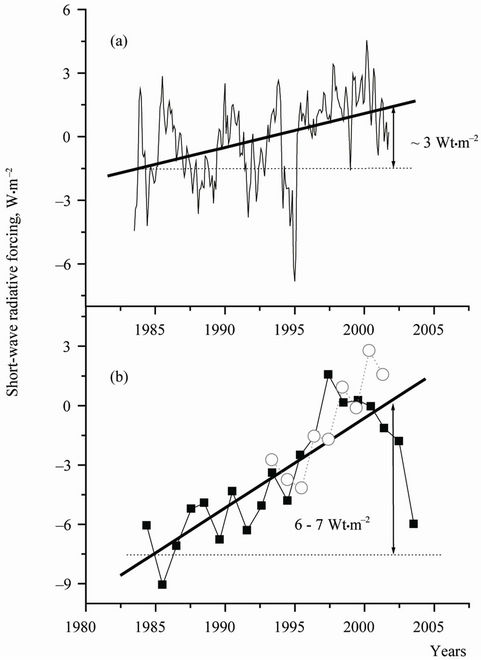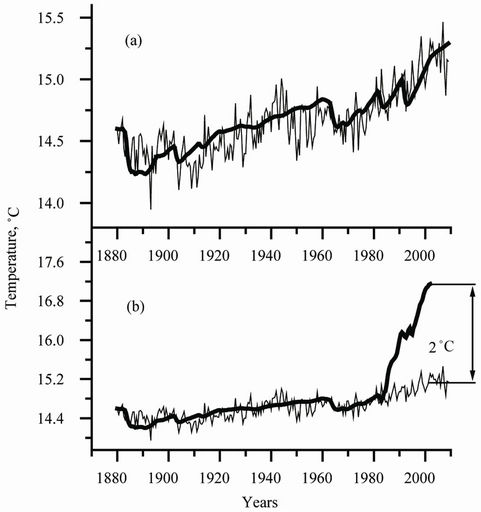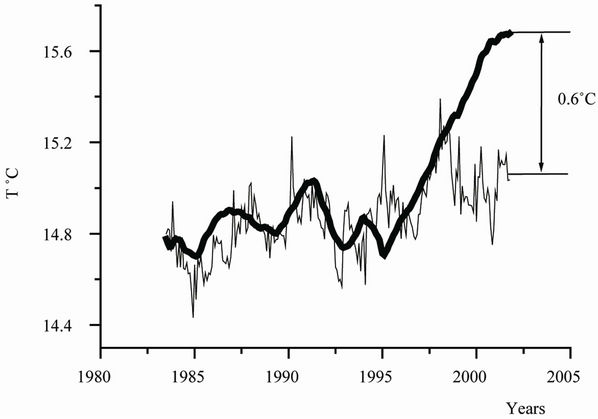Atmospheric and Climate Sciences
Vol. 2 No. 2 (2012) , Article ID: 18825 , 5 pages DOI:10.4236/acs.2012.22019
Background Solar Irradiance and the Climate of the Earth in the End of the 20th Century
1Ioffe Physico-Technical Institute, Russian Academy of Sciences, St. Petersburg, Russia
2General Astronomical Observatory at Pulkovo, St. Petersburg, Russia
3Metla, Rovaniemi, Finland
Email: maxim.ogurtsov@mail.ioffe.ru
Received January 13, 2012; revised February 26, 2012; accepted March 9, 2012
Keywords: Climate; Solar Irradiance
ABSTRACT
The possible response of global climate to the changes of background radiation derived from satellite measurement during 1983-2001 is analyzed. Estimation is made by means of one-dimensional energy-balance climatic model. It is shown that the increase of the global surface radiation by 3 W × m–2 through 1983-2001 should result in a corresponding rise of temperature, which exceeds the actual observed values by 0.6˚C - 2.0˚C. Possible causes of such disagreement are discussed.
1. Introduction
It is generally agreed that the global warming of recent decades is caused primarily by anthropogenic increase of greenhouse gases concentration [1,2]. However, not only human-made variations of atmospheric composition influence global climate. Changes in the climate of the Earth depend evidently on the background solar irradiance, i.e. on the amount of shortwave solar radiation incoming into the atmosphere and the fraction of this radiation, which is reflected back to the space. Recent evidence show that solar radiation incident at the Earth’s surface has increased appreciably in the end of 20th century [3]. The phenomenon is often called a global brightening. Estimations of the radiative forcing (Figure 1) global perturbation of the radiation balance of the terrestrial atmosphere—are based on the following data:
1) Solar radiation at the Earth’s surface, averaged over the globe, which was derived in the work [4] from the data on cloudiness obtained in framework of the International Satellite Cloud Climatology Project (ISCCP) during 1983-2001;
2) Globally-averaged change in solar radiation at the Earth’s surface during 1984-2003, derived from the data on the Earth’s reflectance obtained by Palle et al. [5] using ISCCP data and the data on dayside earthlight reflected from the Moon.
3) Average of the 8 records of anomalies in groundbased observations of the solar radiation incident on the Earth’s surface during 1993-2001 [6].
Change in background solar radiation through 1983- 2001 causes a positive radiative forcing ranging from 3 W × m–2 to 6 - 7 W × m–2 [3] (Figure 1). If we take a value of climatic sensitivity adopted by IPCC (lс = 0.53˚C - 1.23˚C × m2/W) [2], we obtain that increase of the global temperature by 1.5˚C - 3.6°C is a result of the radiative forcing of 3 W × m–2. Thus, an increase of the amount of solar radiation that reaches Earth’s surface in the end of the 20th century, determined in different ways, should cause a jump of the global temperature, which, however, has not been observed. Of course, the oversimplified estimation above is not sufficient for any decisive conclusion. A more precise model assessment is necessary. In the present work such an evaluation is done by means of the energy-balance climate model.
2. Energy-Balance Model of Global Climate
In framework of the energy balance approach, changes in the climate system are estimated from an analysis of the change in the Earth’s heat storage. The basis for these models was introduced by Budyko and Sellers [7,8]. In its simplest form, energy-balance model provides globally averaged values for the computed variables. We use the surface-energy balance climate model coupled with deep ocean with horizontally uniform vertical heat diffusion and a constant upwelling:


Figure 1. Short-wave radiative forcing assessed by means of: (a) Satellite-derived surface radiation (the data were electronically scanned and digitized from [4]); (b) Surface radiation estimated using the data on the Earth’s albedo [5] (solid line with squares), surface radiation estimated using the data on ground-based measurement (dashed line with the empty circles). The data were electronically scanned and digitized from [3,4].
 (1)
(1)
where:  is the global-mean surface temperature,
is the global-mean surface temperature,  is the global-mean temperature of the ocean at the depth z, q is the effective planetary heat capacity,
is the global-mean temperature of the ocean at the depth z, q is the effective planetary heat capacity,  is the absorbed short-wave solar radiation,
is the absorbed short-wave solar radiation,  is the outgoing long-wave terrestrial radiation,
is the outgoing long-wave terrestrial radiation,  is the heat exchange between the surface and the deep layers of the ocean,
is the heat exchange between the surface and the deep layers of the ocean,  describes the different radiative forcings, kz is the vertical heat diffusion coefficient, wz is an upwelling velocity.
describes the different radiative forcings, kz is the vertical heat diffusion coefficient, wz is an upwelling velocity.  is expressed as:
is expressed as:
 (2)
(2)
where h is the depth of the mixed ocean layer.
 (3)
(3)
S(t) is the total solar irradiance (TSI) or the solar constant, a is the terrestrial albedo.  is expressed as a linear function of TS:
is expressed as a linear function of TS:
 (4)
(4)
Effective global heat capacity is determined by formula, generalizing the results of [9]:
 (5)
(5)
where q in W × yr × m–2 × K–1, h in meters.
3. Results
Climate forcings used in calculations (Figure 2) were as follows. Greenhouse gases forcing and anthropogenic (tropospheric) aerosol forcing was taken from [10]. Volcanic (stratospheric) aerosol forcings were taken from [11]. We used three TSI reconstructions obtained in the works [12-14]. The total (net) climate forcing  calculated using TSI reconstruction [14] is shown in Figure 2(f). The same forcing but considering the amount of solar radiation that reaches the Earth’s surface derived from satellite observations
calculated using TSI reconstruction [14] is shown in Figure 2(f). The same forcing but considering the amount of solar radiation that reaches the Earth’s surface derived from satellite observations  is shown in Figure 2(g). The model (1) was solved by the method of consecutive approximation. Initially we obtained the temperature in a zero approximation
is shown in Figure 2(g). The model (1) was solved by the method of consecutive approximation. Initially we obtained the temperature in a zero approximation  by solution of the first equation of the model (1) with the initial condition
by solution of the first equation of the model (1) with the initial condition  = 14.6˚C and without the account of the heat flux from the ocean, i.e.
= 14.6˚C and without the account of the heat flux from the ocean, i.e.  = 0. Then the second equation of (1) is solved with the initial condition:
= 0. Then the second equation of (1) is solved with the initial condition:
 (6)
(6)
and the following boundary conditions:
 (7)
(7)
 (8)
(8)
The second boundary condition [15] describes balance of the heat fluxes—diffusion and upwelling near a bottom compensate the powerful sink of cold water over the areas of the deep water formation (Greenland, Norwegian and Labrador seas in Northern Hemisphere, Weddell and Ross seas in Southern Hemisphere). The polar sea temperature Tp was equal to 1.2˚C [15] and the depth of the ocean H was considered to be 5000 m. The solution of the second equation of (1) with conditions (6-8) brings us . After this we solve the first equation of (1) determining the
. After this we solve the first equation of (1) determining the  with formula (2) by using
with formula (2) by using . This results in the first approximation of the surface temperature
. This results in the first approximation of the surface temperature . Repeating the procedure brings other approximations
. Repeating the procedure brings other approximations ,
,  etc., but the first approximation usually is enough. Calculations are performed by using the following parame-
etc., but the first approximation usually is enough. Calculations are performed by using the following parame-

Figure 2. Climate forcings (in W × m–2) used in calculations. (a) Greenhouse gases forcing [10]; (b) Human-made aerosol forcing [10]; (c) Total solar irradiance reconstructions after Hoyt and Schatten ([12], thick line), Lean et al. ([13], dotted line), Mordvinov et al. ([14], thin line); (d) Volcanic aerosol forcing [11]; (e) Satellite-derived background radiation [4]; (f) Net forcing without the account of a satellite-measured radiation; (g)-(f) Net forcing with the account of a satellite-measured radiation. Time resolution 0.5 year.
ters of the model: kz = 3000 m2 × yr–1, wz = 5 m × yr–1, h = 150 m, α = 0.3, q = 14.6 W × yr × m–2 × K–1, a0 = 204.0 W × m–2, b0 = 2.05 W × m–2 × K–1. The net forcing  and TSI reconstruction [14] are used in calculations (Figure 3(a)). Standard deviation between the temperature calculated from the model and instrumentally measured temperature through 1880-2009 is 0.15. Data on the global temperature were taken from the site ftp://ftp.ncdc.noaa.gov/pub/data/anomalies/monthly.land_ocean.90S.90N.df_1901-2000mean.dat. The use of other TSI records in calculations brings similar results. The model curve reproduces several important features of the global-mean surface temperature (Figure 3(a)). However, if we use the total forcing
and TSI reconstruction [14] are used in calculations (Figure 3(a)). Standard deviation between the temperature calculated from the model and instrumentally measured temperature through 1880-2009 is 0.15. Data on the global temperature were taken from the site ftp://ftp.ncdc.noaa.gov/pub/data/anomalies/monthly.land_ocean.90S.90N.df_1901-2000mean.dat. The use of other TSI records in calculations brings similar results. The model curve reproduces several important features of the global-mean surface temperature (Figure 3(a)). However, if we use the total forcing , which takes into account the global brightening, the divergence between the model and actual temperature reaches 2˚C, i.e. thirteen times more than the modeling error is (Figure 3(b)). Such disagreement, in principle, could appear if the longwave emission
, which takes into account the global brightening, the divergence between the model and actual temperature reaches 2˚C, i.e. thirteen times more than the modeling error is (Figure 3(b)). Such disagreement, in principle, could appear if the longwave emission  during the last decades differs appreciably from the previous values. Therefore it is use-
during the last decades differs appreciably from the previous values. Therefore it is use-

Figure 3. (a) Instrumental global temperature (ftp://ftp.ncdc.noaa.gov/pub/data/anomalies/, thin line), global temperature calculated from the model using net forcing ΔFNET (thick line); (b) Instrumental global temperature (thin line), global temperature calculated from the model using net forcing  (thick line). Time resolution 0.5 year.
(thick line). Time resolution 0.5 year.
ful to test the model over the time interval 1983-2001. Fitting of the model parameters over 1983-2001 showed that the best agreement between the calculated and actual temperature is reached when a0 = 205.0 W × m–2, b0 = 2.2 W × m–2 × K–1 (Figure 4, monthly data were used). Standard deviation between the calculated and instrumentally measured temperature over 1983-1999 is 0.13.
However during 1999-2001 the two curves apparently diverge and the difference reaches 0.6˚C (almost 5 times more than the error over 1983-1999). As in the previous case, calculation using the energy balance model, which considers the data of the surface radiation measurement, greatly overestimates the actual temperature.
4. Conclusions
An analysis of the possible climate response to the changes in solar radiation at the Earth’s surface based on satellite measurements [4] during 1983-2001, performed by means of both qualitative estimations and calculations of the energy-balance model, suggest that the observed increase of the background radiation by 3 W × m–2 should result in a strong rise of the global temperature, which exceeds the actually measured values by 0.6˚C - 2.0˚C. If we use the other experimental estimations of global brightening, which provides 6 - 7 W × m–2 forcing through 1983-2001 [3], the disagreement would be even larger.
It has been suggested that the global brightening starting in 1990s was preceded by prolonged global dimming substantial decrease in surface solar radiation during the period 1960-1990 [16-18]. Thus, solar brightening of recent decades only compensates previous decrease in solar radiation and does not appreciably change the global temperature trend, caused by greenhouse effect [17,18]. It should be noted, however, that the spatial coverage of the surface radiation stations, which data were used in the works [16-18], is rather limited—all the station are situated over the land and they are clustered at the domains of high population density—see Figure 1 of the work [18]. Moreover evidence has been obtained that the dimming of 1950-1980 actually was not global but had local or regional nature and was observed mainly over

Figure 4. Instrumental global temperature (ftp://ftp.ncdc.noaa.gov/pub/data/anomalies/, thin line), global temperature calculated from the model using net forcing  (thick line). Time resolution 1 month.
(thick line). Time resolution 1 month.
areas of high industrial activity [19]. Therefore it is difficult to make a decisive conclusion about the globalscale change in the surface solar radiation over 1960-1990. Thus, we conclude that the experimental estimations of solar radiation that reaches the Earth’s surface apparently contradict with the actually measured global temperatures at least in the framework of the energy balance approach. We believe that the disagreement could be a result of the following causes:
1) The oversimplified energy-balance approach is not enough for analysis of the processes in a real climate system.
2) The rise of temperature, caused by a global brightening during 1983-2001, has been compensated by a currently unknown, extra cooling factor.
In any case, the reaction of a global climate system to changes in background radiation in the end of the 20th century needs further profound investigation using the novel global circulation models.
5. Acknowledgements
M. G. Ogurtsov expresses his thanks to the exchange program between the Russian and Finnish Academies (project No. 16), RFBR grants No. 10-05-00129, 11-02- 00755 for financial support. R. Jalkanen and M. Lindholm thank the Finnish Academy (SA138937) for research support.
REFERENCES
- J. T. Houghton, Y. Ding, D. J. Griggs, et al., “Climate Change 2001: The Scientific Basis,” Intergovernmental Panel on Climate Change (IPCC), Cambridge University Press, Cambridge, 881 p.
- S. Solomon, Q. Dahe, M. Manning, et al., “Climate Change 2007: The Physical Science Basis,” Intergovernmental Panel on Climate Change (IPCC), Cambridge University Press, Cambridge, 996 p.
- E. Palle, P. R.Goode, P. Montanes-Rodriguez and S. E. Koonin, “Can Earth’s Albedo and Surface Temperatures Increase Together?” EOS, Vol. 70, No. 4, 2006, pp. 37-43. doi:10.1029/2006EO040002
- R. T. Pinker, B. Zhang and E. G. Dutton, “Do Satellites Detect Trends in Surface Solar Radiation?” Science, Vol. 308, No. 5723, 2005, pp. 850-854. doi:10.1126/science.1103159
- E. Palle, P. R. Goode, P. Montanes-Rodriguez and S. E. Koonin, “Changes in the Earth’s Reflectance over the Past Two Decades,” Science, Vol. 304, No. 5675, 2004, pp. 1299-1301. doi:10.1126/science.1094070
- M. Wild, H. Gilgen, A. Roesch, A. Ohmura, C. Long, and E.G. Dutton, “From Dimming to Brightening: Trends in Solar Radiation Inferred from Surface Observations,” Science, Vol. 308, No. 5723, 2005, pp. 847-850. doi:10.1126/science.1103215
- M. I. Budyko, “The Effect of Solar Radiation Variations on the Climate of the Earth,” Tellus, Vol. 21, No. 5, 1969, pp. 611-619. doi:10.1111/j.2153-3490.1969.tb00466.x
- W. D. Sellers, “A Global Climatic Model Based on the Energy Balance of the Earth-Atmosphere System,” Journal of Applied Meteorology, Vol. 8, No. 3, 1969, pp. 392-400. doi:10.1175/1520-0450(1969)008<0392:AGCMBO>2.0.CO;2
- S. Schwartz, “Heat Capacity, Time Constant, and Sensitivity of Earth’s Climate System,” Journal of Geophysical Research, Vol. 112, 2007, 12 p. doi:10.1029/2007JD008746
- J. Hansen, M. Sato, P. Kharecha and K. von Schuckmann, “Earth’s Energy Imbalance and Implications,” Atmospheric Chemistry and Physics Discussion, Vol. 11, 2011, pp. 27031-27105. doi:10.5194/acpd-11-27031-2011
- M. Sato, J. E. Hansen, M. P. McCormick and J. B. Pollack, “Stratospheric Aerosol Optical Depths, 1850-1990,” Journal of Geophysical Research, Vol. 98, 1993, pp. 22987- 22994. doi:10.1029/93JD02553
- J. Lean, J. Beer and R. Bradley, “Reconstruction of Solar Irradiance since 1610: Implications for Climate Change,” Geophysical Research Letters, Vol. 22, No. 23, 1995, pp. 3195-3198. doi:10.1029/95GL03093
- D. V. Hoyt and K. H. Schatten, “A Discussion on Plausible Solar Irradiance Variations, 1700-1992,” Journal of Geophysical Research, Vol. 98. No. A11, 1993, pp. 18895-18900. doi:10.1029/93JA01944
- A. V. Mordvinov, N. G. Makarenko, M. G. Ogurtsov and H. Jungner, “Reconstruction of Magnetic Activity of the Sun and Changes in Its Irradiance on a Millennium Timescale Using Neurocomputing,” Solar Physics, Vol. 224, No. 1-2, 2004, pp. 247-253. doi:10.1007/s11207-005-4282-5
- G. C. Reid, “Solar Total Irradiance Variations and the Global Sea Surface Temperature Record,” Journal of Geophysical Research, Vol. 96, No. D2, 1991, pp. 2835-2844. doi:10.1029/90JD02274
- M. Wild, H. Gilgen, A. Roesch, A. Ohmura, C. Long, E. Dutton, B. Fogman, A. Kalis, V. Russak and A. Tsvetkov, “From Dimming to Brightening: Decadal Changes in Surface Solar Radiation,” Science, Vol. 308, No. 5723, 2005, pp. 847-850. doi:10.1126/science.1103215
- M. Wild, A. Ohmura and K. Makowski, “Impact of global Dimming and Brightening on Global Warming,” Geophysical Research Letters, Vol. 34, 2007, 4 p. doi:10.1029/2006GL028031
- M. Wild, “Global Dimming and Brightening: A review,” Journal of Geophysical Research, Vol. 114, 2009, 31 p. doi:10.1029/2008JD011470
- P. Alpert, P. Kishcha, Y. J. Kaufman and R. Schwarzbard, “Global Dimming or Local Dimming? Effect of Urbanization on Sunlight Availability,” Geophysical Research Letters, Vol. 32, 2005, 4 p. doi:10.1029/2005GL023320

